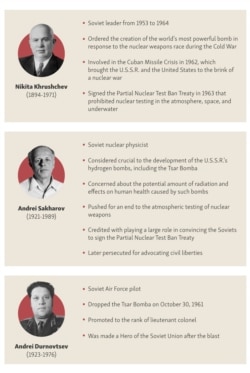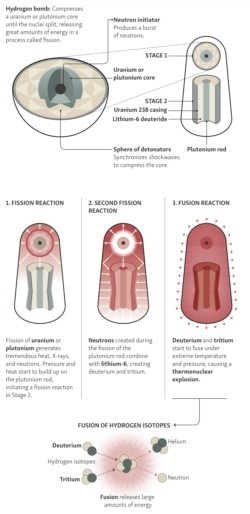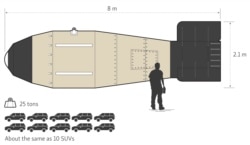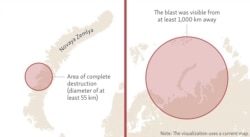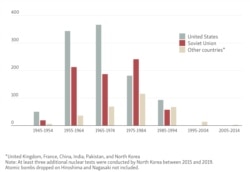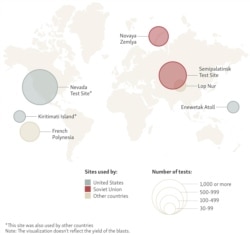On October 30, 1961, the Soviet Union tested the largest nuclear device ever created. The "Tsar Bomba," as it became known, was 10 times more powerful than all the munitions used during World War II.
While its original purpose was to prove to the world, and especially to the United States, that the Soviet Union was capable of producing such devices, it also brought a surprising twist to the future testing of nukes.
The Military Race Is On
At the beginning of the 1960s, the relationship between the Soviet Union and the United States was tense -- the countries were in the middle of the Cold War, struggling for geopolitical, ideological, and military dominance.
The United States had already tested the world's first hydrogen bomb -- called "Mike" -- in 1952 and their biggest nuclear device -- called "Castle Bravo" -- in 1954. The Soviet Union was also working on developing a hydrogen bomb and managed to detonate its first true one in 1955. But that was just the beginning. Soviet leader Nikita Khrushchev was keen to show off the U.S.S.R.'s military prowess, so he ordered the creation of the most powerful bomb ever made.
Who Was Who In Creating The 'Tsar Bomba'?
How Does A Hydrogen Bomb Work?
The Tsar Bomba was a hydrogen aerial bomb, also known as a thermonuclear weapon, which is usually described as a more advanced and powerful version of an atomic bomb. While atomic bombs use either uranium or plutonium in most cases, hydrogen bombs also need additional isotopes of hydrogen, called deuterium and tritium.
The reaction that causes the explosion is also different. Atomic bombs rely on fission -- a process of compressing the core of uranium or plutonium, splitting it into parts, and therefore releasing a huge amount of energy. On the other hand, hydrogen bombs use not only the energy from fission but also secondary fusion, which makes the explosion much stronger.
Specifications of various hydrogen bombs vary. For example, Soviet scientist and dissident Andrei Sakharov, a member of the Soviet nuclear weapons program, came up with a design called "sloika" (layer cake). This method used alternating layers of deuterium (an isotope of hydrogen) and uranium. It was a major contribution to the development of the hydrogen bomb in the Soviet Union.
What Did The Most Powerful Bomb Look Like?
The Tsar Bomba was given many technical names, such as Project 27000, Product Code 202, and RDS-220. It was 8 meters long, its diameter was about 2 meters, and it weighed roughly 25 tons. Its proportions made it very challenging to handle. It was so large that it couldn't be loaded on any plane that the Soviet Union had at that time.
Originally, the bomb was supposed to yield up to 100 megatons, but scientists were concerned about radioactive fallout and potential effects on human health. That's why they eventually decided to use three layers of lead (instead of three uranium layers) and halve the explosion.
Tsar Bomba Scheme
The Day Of The Explosion
On October 30, 1961, a Tupolev Tu-95 plane started its journey from the Olenya airfield on the Kola Peninsula. Although it was the largest plane in the Soviet fleet, it had never carried such a heavy weapon and had to be modified. Nonetheless, the bomb would not fit inside the plane and had to be placed underneath it. In order to reflect the heat caused by the blast, the plane was painted bright white.
Its pilot, Major Andrei Durnovtsev, climbed to 10 kilometers above the ground and flew toward the Matochkin Strait at Novaya Zemlya. He was accompanied by another plane, a Tu-16 bomber, which was supposed to film the blast.
The Tsar Bomba was dropped above the Arctic archipelago of Novaya Zemlya. To give the planes some time to escape the scene, the bomb was equipped with a parachute that was supposed to slow down its fall and make sure the bomb exploded at 4,000 meters. Despite all of the precautions, the survival rate of the crew was calculated at about 50 percent.
At 11:32 a.m. Moscow time, the bomb exploded. It created a fireball about 8 kilometers wide and the flash could be seen from 1,000 kilometers away. All buildings within 55 kilometers of the test site at Sukhoy Nos were completely destroyed; windows within hundreds of kilometers were broken. The shock wave generated after the blast traveled three times around the Earth. It also made the Tu-95 plane drop about 1,000 meters, but the pilot later managed to regain control and landed safely.
The explosion produced about 57,000 kilotons of energy. In comparison, the bombs dropped on Hiroshima and Nagasaki during World War II were equivalent to 15 and 21 kilotons, respectively. The largest nuclear device tested by the United States was 15,000 kilotons.
The bomb's mushroom cloud climbed to 60 to 70 kilometers above the ground. Luckily, the fireball didn't make contact with the Earth, and therefore the level of radiation was relatively small, compared to the size of the bomb. According to some sources, however, radioactive fallout was measured across Scandinavia.
Comparison Of Mushroom Cloud Heights
Selected detonations, in kilometers
What Happened Next?
After the Tsar Bomba had been tested in 1961, nuclear tests continued and Soviet leader Nikita Khrushchev even ordered the detonation of another megaton bomb just a few months later. The following year, the testing reached its peak when a total of 79 nuclear bombs were detonated. However, efforts to end the atmospheric testing of nuclear weapons were also on the rise.
Nuclear Tests By Country
(Atmospheric and underground)
In 1963, the United States, the United Kingdom, and the Soviet Union signed the Partial Nuclear Test Ban Treaty, which prohibited tests in the atmosphere, outer space, and underwater. The deal was later opened to other countries as well. From that point onward, nuclear tests were conducted underground.
Nuclear Test Sites
(Sites with the highest number of tests included)
The Soviet Union conducted its last nuclear test in 1990, the United States in 1992. Four years later, the Comprehensive Nuclear Test Ban Treaty banned nuclear weapons tests in all environments.
